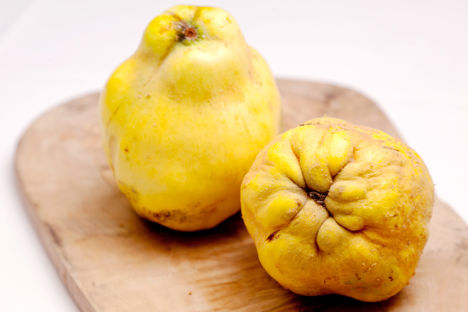
Ingredient focus: quince
Is it an ugly apple or an odd shaped pear? No it's a quince, also part of the rose family with a more floral flavour, look out for this aromatic fruit at farmers markets for a winter treat.
View more from this series:
Ingredient focusOriginating in Asia, quinces can be dated back to 600BC but they were only introduced to the UK a measly 700 years ago. Quinces were extremely popular in medieval times usually served as a jelly with meat or in pies. These days, the fruit is relatively unknown and woefully underused across the country. Though they do grow in the British Isles, the majority of quinces consumed in the UK are imported from Turkey, the world’s largest producer.
Quinces need to be cooked to be edible as they have a harsh woody centre that has to be broken down before eating. They are high in pectin, and therefore great for jam-making. The most well-known application of quince is probably Spanish membrillo, a hard jelly made cooking the fruits at a low temperature for a long time during which chemicals are released and the fruit turns red. Membrillo makes a great accompaniment to cheese and cold meats.
Flavour profile
Quinces have many aromas in common with pears being from the same family. The biggest difference between a quince and a normal pear is the floral aroma (rose-like smell). It also contains some tropical fruity notes in common with fruits such as pineapple and bananas.
Quinces are also high in tannins which give them a unique tartness unlike normal pears. This tartness is almost savoury in flavour which is why quince matches so well with meat. However, when cooked gently for long periods of time (over three hours) the quince gets a deep rose colour and begins to take on deep, sweet caramelised flavours which can be missed if cooking it quickly.
Food matches
Quince pairs best with its cousins apples and pears; for an interesting dessert idea why not try Pain perdu with coffee, pears and quince, a dish devised by Peter Coucquyt. Other flavours that work well with quince include grape; try Geofrrey Smeddle’s Quince, muscat and apple compote with a big slab of cheese like cheddar, brie, emmental and, of course, Spanish manchego.
Quince lends itself to both sweet and savoury dishes; Agnar Sverrisson pairs it with savoy cabbage and pork and Robert Thompson blurs the lines between both with his Bavarois of butternut squash with quince sorbet and poached blackberries.
The tropical notes in quince make it a good match for pineapple, mango and even banana, try serving it as an ice cream or sorbet with caramelised fruit.
Alcohol also works well with quince, particularly wine due to the grape match – try the Galvin Brothers' red-wine-drenched Daube of venison with quince or Geoffrey Smeddle’s sweet-wine-poached quince in his Partridge and quince recipe. Stronger spirits such as bourbon, brandy, rum and even whisky stand up to quince – try adding a little when poaching for an enhanced flavour.
Did you know?
It is said that women in ancient Greece would rub their lips with quince on their wedding day to make them fragrant.
Cooking quinces releases a red pigment called anthocyanin – this is made darker if cooked in aluminium foil due to a chemical reaction.
The word 'marmalade' comes from the Portuguese 'marmelada', which means 'quince preserves'.


